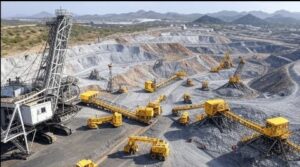Thunder Bay, Ontario: Alset Energy Corp. (TSXV: ION) (“Alset” or “the Company”) is pleased to announce the laboratory results of 30 samples selected from stored historical sampling efforts completed by LitioMex (2009-2011), the former property owner, on three of the Mexican salars, La Salada, Santa Clara, and Caliguey. The laboratory work included a check or “head” assay followed by quantitative X-ray diffraction analysis and a second assay on the less than 2 micron size fraction of the sample. The purpose of the X-ray diffraction was to determine the clay mineral species and their abundance. The original samples were part of a work program conducted by the previous owners whereby 5m holes were dug in the salars on a 100m x 100m grid with five 1m samples collected from each hole and submitted for multi-element analyses. The historical values returned from Inspectorate laboratory for the 30 samples ranged from 411 to 2590ppm lithium compared to the recent results from Activation Laboratories (“Actlabs”) on behalf of Alset which ranged from 340 to 1680ppm lithium. Both laboratories used an induced coupled plasma (ICP) procedure with a four-acid total digestion. Overall the results from Inspectorate seem a bit higher than those produced by Actlabs and may be a result of the remaining portion of each sample used by Actlabs being much smaller. The most important aspect of the current ongoing laboratory work is the XRD (x-ray diffraction) results listed in the table below. Smectite is a group of clay minerals of which the lithium-bearing mineral hectorite is included. Of the 30 samples submitted, no smectite was detected in 12 and only trace was detected in 2 samples. The samples with the highest concentration of smectite, which may or may not be hectorite, came from the Caliguey salar where Mexico’s former Mineral Resource Council sampling of fluid in the salar returned values of 1.2 to 2.1% lithium (see Alset PR September 1, 2016). The evidence suggests that the vast majority of the lithium is not held in hectorite clay where it is difficult and expensive to extract.
Table 1: Mineral abundances in samples in the <2 micron size fraction:
| Salar | Sample No | Illite | Quartz | K feldspar | Plagioclase | Analcime | Calcite | Dolomite | Gaylussite | Trona | Halite | Amorphous & smectite | Smectite as % of clays |
| Santa Clara | 1039 | 46.6 | 2.5 | 1 | 2.3 | 6.2 | 11.6 | n.d. | n.d. | n.d. | 6.1 | 23.7 | n.d. |
| Santa Clara | 26761 | 45.2 | 5.1 | 3.9 | 1.9 | 7 | 10.7 | n.d. | n.d. | n.d. | 4.4 | 21.7 | n.d. |
| Santa Clara | 26935 | 51.4 | 2.2 | 5.2 | 1.9 | 6.2 | 12.4 | n.d. | n.d. | n.d. | 1.6 | 19.1 | n.d. |
| Santa Clara | 12552 | 53.3 | 1.5 | 4.7 | 1.2 | 5.4 | 9.4 | n.d. | n.d. | n.d. | 2.6 | 22 | n.d. |
| Santa Clara | 26851 | 53.2 | 3.4 | 4.7 | 1.7 | 6.4 | 9.4 | n.d. | n.d. | n.d. | 2.8 | 18.4 | n.d. |
| Santa Clara | 13597 | 29.3 | 19.3 | 3.2 | 6.2 | 4.6 | 10.1 | n.d. | n.d. | n.d. | n.d. | 27.4 | n.d. |
| Santa Clara | 13697 | 23.2 | 16.3 | 6.2 | 6.6 | 2.1 | 11.4 | n.d. | n.d. | n.d. | n.d. | 34.2 | n.d. |
| Santa Clara | 13995 | 50.9 | 2.7 | 4.6 | 1.8 | 13.1 | 8.8 | n.d. | n.d. | n.d. | 3.6 | 14.6 | n.d. |
| Santa Clara | 13951 | 47.9 | 2.1 | 5.8 | 4 | 10.6 | 11.2 | n.d. | n.d. | n.d. | n.d. | 18.5 | n.d. |
| Santa Clara | 13632 | 39.1 | 21.6 | 3.3 | 5.7 | 9.6 | 10.5 | n.d. | n.d. | n.d. | n.d. | 10.2 | n.d. |
| La Salada | 612644 | 12.9 | n.d. | 3.6 | n.d. | n.d. | 15.8 | 11.8 | 7.7 | n.d. | 1.5 | 46.7 | Y |
| La Salada | 612622 | trace | 0.7 | 2 | n.d. | n.d. | 9 | 11.4 | 22.3 | n.d. | 2.7 | 51.8 | trace |
| La Salada | 612696 | 8 | n.d. | 6.5 | n.d. | n.d. | 34.3 | 3.8 | n.d. | n.d. | 1.3 | 46 | n.d. |
| La Salada | 612635 | 10 | 4.3 | 5.3 | n.d. | n.d. | 28.9 | 10.1 | n.d. | n.d. | 2.3 | 39.1 | 78 |
| La Salada | 612709 | 8 | n.d. | 6.4 | n.d. | n.d. | 24.2 | 5.9 | n.d. | n.d. | 1.3 | 54.2 | Y |
| La Salada | 612660 | 11 | 0.5 | n.d. | n.d. | n.d. | 19.9 | 10 | n.d. | 5.9 | 0.9 | 51.8 | Y |
| La Salada | 612702 | 7 | n.d. | 4.7 | n.d. | n.d. | 33.5 | 5.7 | n.d. | n.d. | 1 | 48 | Y |
| La Salada | 612650 | 8 | n.d. | 3.2 | n.d. | n.d. | 29.8 | 7.2 | n.d. | n.d. | 0.6 | 51.2 | 80 |
| La Salada | 612710 | 7 | n.d. | 3 | n.d. | n.d. | 19.2 | 7.2 | n.d. | n.d. | 1.2 | 62.4 | trace |
| La Salada | 612687 | 4 | 7.5 | 3.8 | n.d. | n.d. | 37.6 | 4.6 | n.d. | n.d. | 1.2 | 41.3 | 80 |
| Caliguey | 820767 | 37.6 | 1.8 | 17.7 | 1.7 | n.d. | 8 | n.d. | n.d. | n.d. | 0.3 | 32.8 | n.d. |
| Caliguey | 820777 | 20.2 | n.d. | 13.3 | n.d. | n.d. | 10.3 | 9.9 | n.d. | n.d. | 0.7 | 45.6 | 40 |
| Caliguey | 10560 | 24.5 | 0.6 | 14.7 | n.d. | n.d. | 11.4 | 10.6 | n.d. | n.d. | 2.3 | 36 | 40 |
| Caliguey | 10596 | 11 | 9.7 | 8.3 | 7.1 | n.d. | 17.8 | 3.6 | n.d. | n.d. | 0.9 | 41.6 | 70 |
| Caliguey | 820762 | 24.2 | 7.8 | 17 | 10.8 | n.d. | 12.2 | n.d. | n.d. | n.d. | 1.2 | 26.8 | 40 |
| Caliguey | 820797 | 14 | n.d. | 6.4 | 4.7 | n.d. | 37.2 | n.d. | n.d. | n.d. | n.d. | 37.7 | 65 |
| Caliguey | 10556 | 48.7 | 3.5 | 14.9 | 7.9 | n.d. | 5.9 | n.d. | n.d. | n.d. | 0.8 | 18.4 | 8 |
| Caliguey | 10562 | 6 | 1 | 7.3 | 8.5 | n.d. | 38.5 | n.d. | n.d. | n.d. | n.d. | 38.7 | 95 |
| Caliguey | 10383 | 42.6 | 3.4 | 3.9 | 4.7 | n.d. | 7.9 | 16 | n.d. | n.d. | 0.3 | 21.3 | 14 |
| Caliguey | 820792 | 18.2 | 17 | 16.8 | 21.4 | n.d. | 8.3 | n.d. | n.d. | n.d. | 0.8 | 17.6 | 5 |
Note: n.d. = no detection,Y = present but relative proportions of smectite and illite were not calculated for samples containing poorly crystalline smectite-like mineral, all values of elements above are percentages of total sample composition
In addition to the promising lithium grades, the potassium was equally as encouraging and potentially represents an important co-product with economic significance. Historical values returned from Inspectorate varied from 1.56 to 10% potassium and 1.57 to 4.78% from Actlabs for the same samples. Only background levels of uranium were detected and will not present any complications.
Another interesting aspect of the samples was that they all contained silver, ranging from 0.5 ppm to 4.3 ppm (gpt). Geothermal activity is one of the first order characteristics in the preliminary deposit model for formation of lithium brines. The silica sinters and carbonate growth textures at the Mexican salars are ample evidence of the geothermal activity, specifically epithermal processes. It is worth noting that this same geological process is also what typically produces many gold-silver deposits and these Mexican salars are situated in one of the most prolific silver producing regions in the world. The Company plans on following up on the silver potential of our projects as well.
Allan Barry Laboucan, President and CEO of Alset stated: “We have just started the first phase in testing the chemical composition of our salars and our team is delighted with the results. In addition to the encouraging lithium results the potassium grades are encouraging as well. Currently Mexico imports all of its potassium and a domestic source would not only be a cost saver for Mexico but would create job opportunities in a crucial commodity for the farming sector. Furthermore, the silver results suggest there may be potential for precious metals as well and further work is required to assess this potential. We are still in the very early stages of assessing the realistic potential of the projects. I’m excited about these results and look forward to the upcoming leach tests on these samples prior to follow-up drilling at several of the salars in the early part of 2017.”
Methodolgy: Thirty samples were submitted to Activation Laboratories (Zacatecas, Mexico and Ancastor, Ontario, Canada) for quantitative X-ray diffraction analysis including clay speciation. The quantitative XRD analysis was performed on a pulverized bulk sample. A portion of each pulverized sample was mixed with corundum and packed into a standard holder. Corundum was added as an internal standard, to determine the amount of poorly crystalline and X-ray amorphous material. For clay speciation analysis, a portion of each sample was dispersed in distilled water and clay minerals in the < 2 μm size fraction separated by gravity settling of particles in suspension. Oriented slides of the < 2 μm size fraction were prepared by placing a portion of the suspension onto a glass slide. In order to identify expandable clay minerals, the oriented slides were analyzed air-dry and after treatment with ethylene glycol.
The X-ray diffraction analysis was performed on a Panalytical X’Pert Pro diffractometer equipped with Cu X-ray source and an X’Celerator detector and operating at the following conditions: 40 kV and 40 mA; range 5-70 deg 2θ for random specimens and 3 – 35 deg 2θ for oriented specimens; step size 0.017 deg 2θ; time per step 50.165 sec; fixed divergence slit, angle 0.5° and 0.250; sample rotation 1 rev/sec. The X’Pert HighScore plus software along with the PDF4/Minerals ICDD database were used for mineral identification. The quantities of the crystalline mineral phases were determined using Rietveld method. The Rietveld method is based on the calculation of the full diffraction pattern from crystal structure information. The amount of poorly crystalline minerals such as smectite could not be calculated by the Rietveld refinement. Instead, the amounts of the crystalline minerals were recalculated based on a know percent of corundum and the remainder to 100 % was considered poorly crystalline and X-ray amorphous material. The relative proportions of the clay minerals in the < 2 μm size fraction were calculated using ratios of their basal-peak areas.
Clinton Barr, PGeo, Vice-President of Exploration for Alset Energy Corp., is the qualified person responsible for this release and has prepared, supervised and approved the preparation of the scientific and technical disclosure contained within the release.
About Alset Energy (ION.V)
Alset Energy is a TSX-V listed junior exploration company focused on exploring and acquiring mineral properties containing the metals needed by today’s high-tech industries. The Company is actively exploring in Mexico and Canada.
On behalf of the Board of Directors of Alset Energy Corp.,
"Allan Barry Laboucan"
Allan Barry Laboucan, President and CEO
THE TSX VENTURE EXCHANGE HAS NOT REVIEWED AND DOES NOT ACCEPT RESPONSIBILITY FOR THE ADEQUACY OR ACCURACY OF THIS RELEASE.
The information contained herein contains "forward-looking statements" within the meaning of applicable securities legislation. Forward-looking statements relate to information that is based on assumptions of management, forecasts of future results, and estimates of amounts not yet determinable. Any statements that express predictions, expectations, beliefs, plans, projections, objectives, assumptions or future events or performance are not statements of historical fact and may be "forward-looking statements."
Forward-looking statements are subject to a variety of risks and uncertainties which could cause actual events or results to differ from those reflected in the forward-looking statements, including, without limitation: risks related to failure to obtain adequate financing on a timely basis and on acceptable terms; risks related to the outcome of legal proceedings; political and regulatory risks associated with mining and exploration; risks related to the maintenance of stock exchange listings; risks related to environmental regulation and liability; the potential for delays in exploration or development activities or the completion of feasibility studies; the uncertainty of profitability; risks and uncertainties relating to the interpretation of drill results, the geology, grade and continuity of mineral deposits; risks related to the inherent uncertainty of production and cost estimates and the potential for unexpected costs and expenses; results of prefeasibility and feasibility studies, and the possibility that future exploration, development or mining results will not be consistent with the Company's expectations; risks related to gold price and other commodity price fluctuations; and other risks and uncertainties related to the Company's prospects, properties and business detailed elsewhere in the Company’s disclosure record. Should one or more of these risks and uncertainties materialize, or should underlying assumptions prove incorrect, actual results may vary materially from those described in forward-looking statements. Investors are cautioned against attributing undue certainty to forward-looking statements. These forward looking statements are made as of the date hereof and the Company does not assume any obligation to update or revise them to reflect new events or circumstances. Actual events or results could differ materially from the Company’s expectations or projections
For further information contact Allan Barry Laboucan @:
Phone (604)-505-4753
Investor Relations:
Daniel Boase
Phone (416)566-2673
Original Article: https://alsetenergy.ca/news/2016/alset-receives-assay-and-xrd-results-for-mexican-salars
















